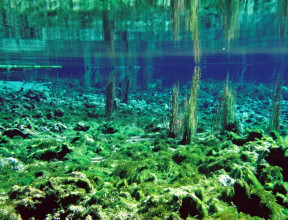
Our Natural Resources

Sitting atop the ancient Te Riu-a-Māui Zealandia continent and astride an active plate boundary has created rich natural resources we can use as we move to a low-carbon future.
Elements and energy
When we talk about our natural resources, we’re talking about how we can harvest energy sources and use critical elements and materials to meet today’s needs while also addressing sustainability and net-carbon emission reductions.
We need to know more about how heat, magma and metals move within the crust because of our greater reliance on geothermal energy. Critical elements are required in many low-carbon technologies and knowing where they are distributed in the subsurface may be vital to support the transition to a low-emissions future.
Our research
Our Te-Riu-A-Māui Zealandia programme provides the underpinning science to understand our volcanic past and the implications for volcanic eruptions, geothermal systems and mineralisation. Our research traverses the length of New Zealand ‘s tectonic activity and offshore to the Harve Trough, the volcanoes of the Kermadec active arc front and the Hikurangi subduction zone.
Zealandia’s older crystalline basement rocks potentially host commercially viable quantities of critical elements required in many low-carbon technologies, including electric vehicles and wind turbines.
Aggregates are critical for infrastructure, and it’s essential that we find sources close to areas of major development to substantially reduce cartage costs and associated carbon emissions.
Key questions driving our research
- How does volcanism and geothermal systems in Aotearoa New Zealand link to magma, heat production and crustal fluid circulation?
- How can New Zealand sustainably access and use our critical elements and geological materials to secure essential resource supplies and reduce carbon emissions?
- What are the physical properties of the crust and how do they evolve and affect seismicity and heat flow in Aotearoa New Zealand?
- What role do Earth surface and sea floor processes play in defining the changing dynamic of Aotearoa New Zealand's landmass?
Geothermal, key to the carbon neutral future. – Geothermal is a natural energy source that can be used to generate electricity. transcript
Geothermal, key to the carbon neutral future.
Why is geothermal the key to a carbon neutral future?
Geothermal is a natural energy source that can be used to generate electricity. Geothermal systems are found in areas where there are lots of volcanoes.
In Aotearoa, New Zealand, most geothermal fields are found in the Taupō volcanic zone in the central North Island.
In this volcanic zone, CO2 is emitted naturally, let's look at this process.
Magma in the earth's crust heats water held in natural reservoirs. As the water heats, CO2 from the magma dissolves into the water.
When hot water rises, CO2 is released from the water.
Gas then escapes through hot pools, natural vents called fumaroles, or steam that escapes through the soil.
Gas that includes CO2.
So how can geothermal energy be carbon neutral? Let's examine how geothermal power plants work.
Water and steam are piped up from the geothermal reservoir under the ground.
Steam rotates the turbines.
A generator produces electricity, and then the water is injected back into the reservoir. This helps maintain pressure in the system.
When the water turns into steam, so do the gases, and at a geothermal power plant, even though the water is re-injected into the system, it may not include all the CO2. Some CO2 is released into the atmosphere. Scientists in the geothermal industry, including at GNS science are developing techniques to stop these gases escaping. It involves re-dissolving the CO2 in water then re-injecting it back into the reservoir.
Doing this helps maintain the geothermal system, while keeping the CO2 underground where it can't damage the environment.
Geothermal scientists are working towards a carbon neutral future.
Geothermal energy will give New Zealand energy security and help New Zealand reach its goals of 100% renewable energy, and net zero carbon emissions by 2050.
Geothermal, key to the carbon neutral future.
Geothermal is a natural energy source that can be used to generate electricity






